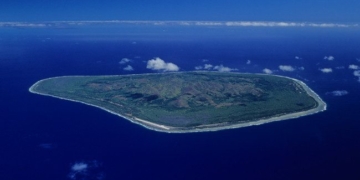A widespread rain event expected from late afternoon to night may cause landslides and flash floods in the northern mountainous regions, complicating response efforts.
Northern Vietnam experienced rain last night due to the influence of a low-pressure trough moving down from the north. Rainfall from 7 PM yesterday to 8 AM today in Tràng Xá (Thái Nguyên); Hùng Quốc, Trường Hà (Cao Bằng) exceeded 100 mm. Many other areas such as Yên Bái, Quảng Ninh, Bắc Kạn, Tuyên Quang, and Hà Giang received more than 90 mm of rain.
Early morning on August 11, heavy rain caused flooding and localized inundation in several places in Cao Bằng, such as Pắc Bó, Hà Quảng district, and Trùng Khánh district. In Chiềng Lao Commune, Mường Lay district, Sơn La province, landslides caused walls to collapse, injuring two young children who were sleeping.

Landslide in Tà Xùa, Sơn La on August 10. (Photo: Bắc Yên District Military Command)
The National Center for Hydro-Meteorological Forecasting has stated that from now until August 17, northern Vietnam will experience heavy rainfall, with peak rainfall expected to be between 60-120 mm, and localized areas receiving over 250 mm, particularly from August 11 to August 13. The intense rainfall is expected to occur mainly in the late afternoon and at night over a limited area (at the provincial level), thus posing a high risk of flash floods, landslides, and inundation in low-lying areas, especially in the northern mountainous provinces.
According to the American Accuweather, Hanoi’s temperatures next week are expected to range from 26-32 degrees Celsius, with the highest temperature reaching 34 degrees Celsius on Thursday. Locations above 1,500 meters above sea level, such as Sapa (Lào Cai), will see temperatures between 17-26 degrees Celsius throughout the week.
In Central Vietnam, the provinces of Thanh Hóa and Nghệ An will be affected by the low-pressure trough in the north, leading to rain showers and thunderstorms tonight and tomorrow evening. The heat wave will be concentrated in the provinces from Hà Tĩnh to Bình Thuận, with maximum daily temperatures generally ranging from 35-37 degrees, and some areas exceeding 37 degrees Celsius.
In the Southern region and The Central Highlands, rain showers and thunderstorms are expected from now until August 13 in the evening. From August 14 to 17, the southwest monsoon will weaken, and rainfall will continue to decrease.
Maximum temperatures in the Southern region will typically range from 32-34 degrees Celsius, while in the Central Highlands, temperatures will range from 29-32 degrees Celsius. Starting from July 14, temperatures in the Southern region will rise to 33-35 degrees Celsius, with localized heat waves in Southeastern Vietnam, and temperatures in the Central Highlands reaching 30-33 degrees Celsius.
The Northern region has just experienced nearly a week of hot weather, but mountainous provinces continue to experience rain showers and thunderstorms in the late afternoon and at night. Soil moisture in many areas has reached saturation, resulting in a very high risk of landslides.
Yesterday, the Ministry of Agriculture and Rural Development continued to urge the People’s Committees of northern provinces to monitor weather developments, organize inspections in areas at risk of flash floods and landslides. Local authorities are to set up guards at crossings, areas that have or are at risk of landslides, preventing people from passing; and be prepared with forces and equipment for rescue and relief when required.


















































